
GARDEN GOALS![]()
![]()
Motivation
![]() Why Natives
Why Natives
![]() Garden Goals
Garden Goals
Site Preparation
![]() Site Analysis
Site Analysis
![]() Site Plan
Site Plan
![]() Hardscapes
Hardscapes
Plant Selection
![]() Which Native
Which Native
![]() Planting Hints
Planting Hints
![]() Suggested Plants
Suggested Plants
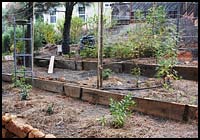
A terraced slope made space for a vegetable garden. As the owners located a source for the natural red rock in the area, the boards were replaced with rock walls.
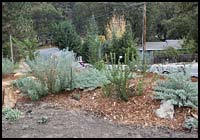
Native plants on a mound started out a year before in 2-inch pots.The small plants grew quickly.
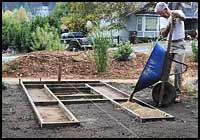
One spouse wanted a horseshoe pit, so native plants and horseshoes co-exist.
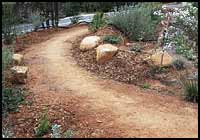
The other spouse wanted rocks for sitting and for a conversation area.
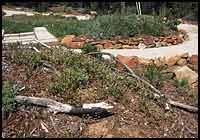
Using dead limbs as a deer deterrent to block deer pathways is an unproven experiment and an effort to use natural materials. It seems to limit the animal traffic, but it may be that the deer simply find it easier to walk on the pathways.
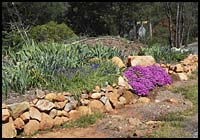
Local rock was used for a wall along the street side of the native garden. Non-native iris, phlox and bulbs add seasonal color and contrasting foliage.
![]()
Garden Goals
Five attributes to consider in developing a landscape plan:
- productivity
- interest
- sustainability
- low maintenance
- flexibility
Productivity means that the landscape will serve its occupants as an extension of their living space. Residents need to think about their preferences and needs. Do they want areas for socializing, for privacy, for food production, for animals, for flowers and for general beauty? Specific features might include fruit trees, a vegetable garden, a barbecue pit, space for children’s play, a cutting garden, a butterfly or bird garden, water features, utility areas, pastures, etc.
Interest in the landscape provides sensory appeal that changes with the seasons and invites people to spend time in the garden. It capitalizes on the many forms, textures, colors and fragrances offered by plants and complemented by physical structures, such as pathways, walls, arbors and fences.
Sustainability means that the garden will require a low amount of resources, with no excessive use of fertilizer, pesticides or water. Techniques include the use of mulches, composting and drip irrigation. Local materials are used as much as possible in constructing garden features.
Low maintenance appeals to busy homeowners and ensures that the garden will remain attractive during periods of neglect. For example, trees and shrubs can be allowed to grow naturally without frequent pruning if planted with adequate space for their mature size. Plants that are appropriate for the planting zone, as described in the Sunset Western Garden Book, will survive freezing weather and hot summers without excessive effort. Diligent removal of the most invasive plants will cause them to disappear after several years. By not planting a lawn, homeowners use less fertilizer and water and expend less energy and time in mowing.
Flexibility allows the landscape to evolve over time. A maturing landscape will transform patterns of sunlight and shade, with the result that some plants may need to be moved or replaced. The owners’ needs and interests also change, depending on their status as full-time workers, parents or retirees.